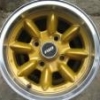Leaderboard
Popular Content
Showing content with the highest reputation on 01/18/19 in all areas
-
10w40 would be just fine. Even 15w50 would be fine. The 0w20 spec is for fuel economy. The clearances in the engine don't change AT ALL on a 0w20 vs a 10w30 engine. They change the oil recommendation based on fuel economy, and film strength depending on engine load (turbo vs non, etc). We run the same clearances in engines making 600+ HP on high boost. We just run them with 15w50 Dominator race oil instead of 10w30 because we need the film strength. Honestly we rarely run anything lower than a 5w40 because Subaru engines blow out their main bearing tolerance within a few tens of thousands. I tore down a 24k WRX engine (no modifications) and the main bearing clearances were already out of spec. Changing the weight will NOT throw any codes. We routinely run 40 and 50 weight oils in engines with AVCS, dual AVCS, and AVLS. Never had one throw a code from it. That's BS. The engine doesn't even have an oil temp sensor. And the duty solenoids use feedback from the cam position sensors, etc to adjust the duty signals. They do not rely on anything as crude as oil viscosity. Which often drops as the oil sheers from use when considering synthetics. GD2 points
-
yeah, nobody should try this at home. Unless they want to. But don't take my confidence and enthusiasm as an endorsement of this as a "good idea" in any way. EXPERIMENTAL. WILL NOT BE DRIVEN ON ROAD UNTIL LOTS OF TESTING.1 point
-
Well I don't know about any of that NASIOC stuff, but I can tell you from building engines, breaking engines, and running them on my dyno - plus hundreds of hours of research, discussion with respected engine builders, Amsoil's technical department, etc that oil viscosity isn't going to make any serious differences in the way the engine will run - you use light oil for light loads and MPG. You use heavy oil for heavy loads and take the MPG hit. Anything between an SAE 20 and an SAE 60 is going to run more or less the same - it will have some mild effects on oil pressure and temperature but for daily driving under light loads anything in that range will adequately lubricate the engine. Anyone that is obsessed with oil viscosity in their ho-hum daily driver factory engine is only doing so because of a lack of fundamental understanding. If they understood oil and engine clearances the way an engine builder does they wouldn't be concerned in the least. It just doesn't matter. I run all my engines hard - factory or not. So I don't run anything less than a 40 in my cars. Ever. Regardless of "manufacturer recommendations" GD1 point
-
Gosh, this is starting to feel like NASIOC with all this talk of oils and bearing clearances. Is that Uncle Scotty I hear? d00000000000000000d!!!!!1 point
-
Exactly. If i would have just glanced at the stupid thing before installing! I took the time to lap the valves with that two part compound and all that other nonsense. I thought i was the man, but i had egg on my face. Luckily they sell single head gaskets for like $15 and you can reuse the bolts And i did learn the easiest way to install the timing belt from that ordeal however!1 point
-
Upping the weight could throw a code for the active valve system.. If it's using that much oil it will fail their test and you'll get a new short block. The warranty on that only covers to 100k so best to get it now while you can1 point
-
If it is using oil like crazy I would up the weight. At least a 10w30 but myself I would use the 0w40, being it is going thru that much oil.1 point
-
Since it goes through that much anyway I would just get whatever is on sale. As long as you stick with the 0W-20 Synth like is recommended you should be fine. I'm sure you will get a dozen different opinions on this, that is mine1 point
-
Suberdave's cars are Awesome! I especially like his '87 GL Coupe with a supercharged EG33 in the back Supercharged GL Coupe1 point
-
Man i think i have all you bozos beat. I have told this story before but... My first ej22 swap and first top end rebuild on a subaru i mixed up the intake and exhaust valves! I'm sitting there blaming the wiring for my engine running on two cylinders! Lol! Luckily I did a compression test and when i pulled the head i saw something that i must have done drunk, cause i don't remember that! Super luckily this was a clandestine pre-test start because I was so confident that i was going to bring my girlfriend at the time who very reluctantly let me take the ea82 out of "our" project. I would have been in the doghouse had she heard that mess, the ej22 actually revs up pretty smooth on two cylinders! By the doghouse i mean the one in my 77 g10. I came clean in the end and showed her the video. We had a good laugh1 point
-
Steady blinking indicates the market the ecu is from, and there’s are no stored codes. Mid codes are stored, these would be flashed instead of the market designation. Cheers Bennie1 point
-
I have a story to tell about one of my adventures. I had bought a project car that was not running when I bought it and I didn't know much history about it. I was doing an engine swap because the original was seized, I had an engine from a 2000 Outback that I wanted to put in a 2001 Outback. No big deal I had done several before. I had done the headgaskets already on the donor engine so I just needed to just swap the cam gears, crank gear and intake manifold and some minor modification to the breather hoses in the area of the PCV valve no big deal. So I stick the replacement engine in and go to bolt up the flex plate and it isn't lining up the bolt holes are about 1/4 inch off. Come to find out the previous owner had put in a transmission out of a forester and the torque converter was a slightly smaller diameter. I had to take the engine back out to swap flex plates. I was a little worried until I did the research, I wasn't sure if a forester tranny was the right one but found out the final drive ratio is the same so it all worked out.1 point
-
As you've all illustrated, our work exists on a continuum from the "fun and games, keeping my own stuff running and staying stimulated by learning new things", through work for an employer and/or customer, to mission-critical/man-rated, where mistakes have the most serious consequences. As fate has had it, I've never been involved in the latter, and some of the very best programmers I've ever worked with have been categorical about not wanting that kind of responsibility. My career has been in the middle, and often as a contractor, where those mistakes sometimes came out of my own pocket. But back at the lighter end of the scale, here's another learning-on-the-fly boner move: For the longest time I had a persistent - and increasingly severe - drivetrain vibration in my old beater '91 Dakota 4x4. At one point I was so frustrated I was determined to just start disconnecting things until something changed. So off came the front driveshaft. No change. Then one front drive axle - I pulled it out and took it for a spin. No change. Then the other drive axle. I headed out our driveway and about a quarter mile down the access road to the secondary highway (we're out in the country). As I pulled out onto the highway, both front bearings (without the axles supporting the load) gave out, planting the front end on the pavement with the wheels splayed out like in a cartoon, or a newborn colt that can't quite stand up yet. I wish I'd had a camera - as I stood back and looked at it I just couldn't stop laughing. Then I trudged home, got the jacks and tools, and sorta wedged it all back together again well enough to limp back to the garage. To cap it, while I was fetching the tools, my girls' school bus driver passed by the poor thing, so the story got around. As my former business partner and I say: We know it's built right because we did it six times.1 point







